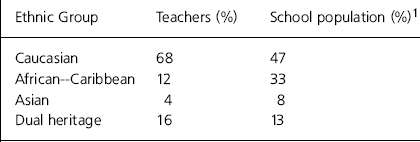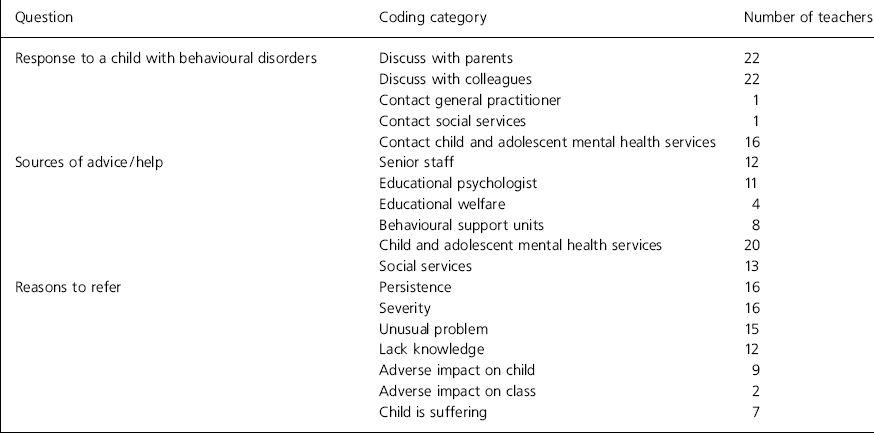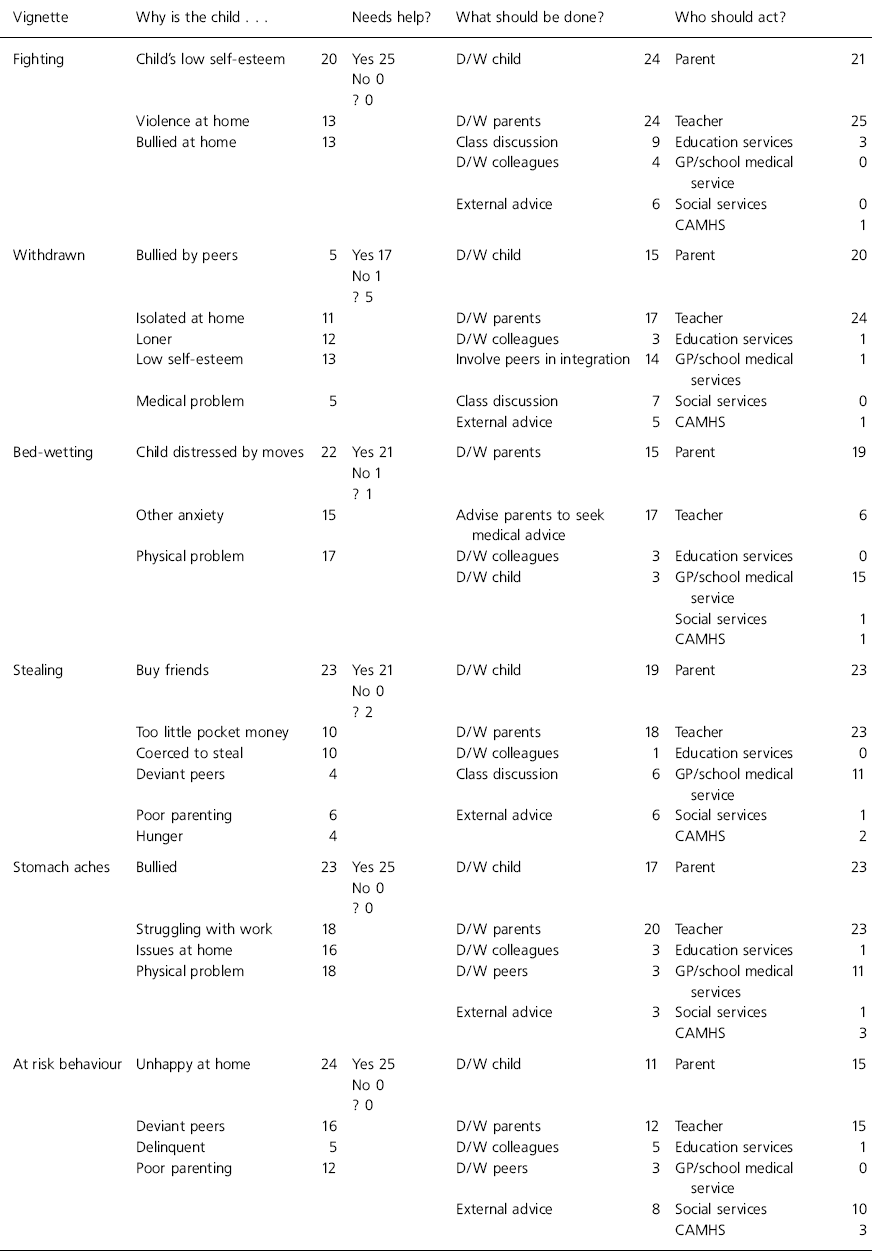Parental histories may be distorted by ongoing family stress or psychopathology. Teachers change from year to year, so their opinions are less systematically biased and are moderately stable over time (Verhulst & van de Ende, 1991). They predict poor outcomes, particularly in girls (Reference Verhulst, Koot and Van Der EndeVerhulst et al, 1994), with externalising disorders (Verhulst & van de Ende, 1991, Reference Verhulst, Koot and Van Der EndeVerhulst et al, 1994) and social problems, as accurately as parents (Reference Verhulst, Koot and Van Der EndeVerhulst et al, 1994).
As a significant influence on children's socio-emotional development (Reference Maughan, Rutter and HayMaughan, 1994), schools are a logical point of intervention for child mental health professionals (Hendron et al, 1994). Even with increased resources, child and adolescent mental health services (CAMHS) alone are unlikely to be able to meet the needs of children with behavioural and psychological problems, leaving schools an important role in mental health promotion (Mental Health Foundation, 1999).
Developed from a project examining the impact of culture on parental attitudes towards children's mental health (Reference Nikapota, Cox and RajNikapota et al, 1998), this study aimed to improve our understanding of teachers' experience of CAMHS in order to improve collaboration. A third of our referrals were from schools, making us aware that local teachers felt increasingly overwhelmed by behavioural problems.
The study
A semi-structured interview devised for the parent study (Reference Nikapota, Cox and RajNikapota et al, 1998) was adapted for teachers. As the parent study involved 9- to 11-year-olds, we interviewed teachers involved with this age group.
The interview covered the following areas:
-
(a) desirable and undesirable attributes and how they can be fostered or discouraged;
-
(b) how they would identify and deal with a child with behavioural disorders;
-
(c) sources of advice, their experience of such services, and the types of problems they would refer.
We used open questions with prompts to ensure that all three areas were discussed, but (b) and (c) were also explored with vignettes chosen to illustrate common behaviours (see appendix 1).
Of 28 primary schools in the local education authority (LEA), 13 agreed to participate. Owing to cancellations (2) and time constraints (5), only 25/32 volunteers from 11 schools were interviewed. Head-teachers who gave a reason for declining to participate thought their staff were too overworked.
The ‘framework model’ of quantitative data analysis (Reference Ritchie, Spencer, Bryman and BurgessRitchie & Spencer, 1994) uses intensive study of transcripts to define emerging themes and form a framework that is applied systematically to the raw data. This method was used to develop a coding manual for the parent survey (Reference Nikapota, Cox and RajNikapota et al, 1998) that we used to classify the teachers' responses. An independent rater reviewed five transcripts, with complete agreement on 60% of the responses.
Findings
Demographic data
The teachers were between 22 and 61 years old (mean age 39.4), and most were female (72%), Caucasian (68%) and married/cohabiting (72%). The period for which they had taught at their current school ranged from one term to 31 years (median 4 years) (see Table 1).
Table 1. Comparison of the ethnic background of teachers who participated in the survey compared to the school population in the same borough at that time

| Ethnic Group | Teachers (%) | School population (%)1 |
|---|---|---|
| Caucasian | 68 | 47 |
| African-Caribbean | 12 | 33 |
| Asian | 4 | 8 |
| Dual heritage | 16 | 13 |
Attitudes towards children's emotions and behaviour
Social behaviour towards peers was the most cited area of functioning: 21/25 teachers mentioned aggression, 13/25 mixing with others and 11/25 caring/being helpful. This contrasts with the study on parents' attitudes (Reference Nikapota, Cox and RajNikapota et al, 1998). Parents focused on social behaviour towards adults (214/220 discussed trust, no teachers mentioned it) and academic failure (216/220 parents cf. 2/25 teachers).
Teachers saw themselves as role models and used a combination of rewards and punishment within clearly defined rules to manage children's behaviour. Supervision (11/25 cf. none of the parents in the previous study) was considered more important in promoting good behaviour, while attending out-of-school clubs had a greater role in preventing naughtiness (16/25). They considered their own upbringing (23/25) and teaching experience (20/25) as important influences on their attitudes towards children, whereas few mentioned their training (12/25) or the social environment in which they worked (4/25) (see Table 2).
Table 2. Teachers' responses to the open questions

| Question | Coding category | Number of teachers |
|---|---|---|
| Response to a child with behavioural disorders | Discuss with parents | 22 |
| Discuss with colleagues | 22 | |
| Contact general practitioner | 1 | |
| Contact social services | 1 | |
| Contact child and adolescent mental health services | 16 | |
| Sources of advice/help | Senior staff | 12 |
| Educational psychologist | 11 | |
| Educational welfare | 4 | |
| Behavioural support units | 8 | |
| Child and adolescent mental health services | 20 | |
| Social services | 13 | |
| Reasons to refer | Persistence | 16 |
| Severity | 16 | |
| Unusual problem | 15 | |
| Lack knowledge | 12 | |
| Adverse impact on child | 9 | |
| Adverse impact on class | 2 | |
| Child is suffering | 7 |
The most common barrier to managing children with behavioural disorders was problematic relationships with parents: 17/25 reported lack of support from parents and 11/25 poor parenting.
Attitudes towards child and adolescent mental health services
Of 20 teachers who had experience of CAMHS, four thought CAMHS had not helped. There were spontaneous complaints about slow response (9/25) and poor communication (13/25). One teacher described an occasion where both she and a mental health worker had suggested that a child record his feelings in a book, resulting in the child and family feeling unsure what should be written in each book.
Response to the vignettes
Most teachers thought children required help, but not necessarily from professionals. If external agencies were suggested, teachers varied their recommendations with the behaviour displayed, for instance, the child running away prompted referrals to social services (10), whereas bed-wetting was seen as the parents' (19) or the general practitioners' (15) responsibility. The most common response involved discussions with the child and their parents, but class discussions were used to deal with general issues such as bullying and fighting (see Table 3).
Table 3. Teachers' responses to the vignettes

| Vignette | Why is the child… | Needs help? | What should be done? | Who should act? | |||
|---|---|---|---|---|---|---|---|
| Fighting | Child's low self-esteem | 20 | Yes 25 | D/W child | 24 | Parent | 21 |
| No 0 | |||||||
| ? 0 | |||||||
| Violence at home | 13 | D/W parents | 24 | Teacher | 25 | ||
| Bullied at home | 13 | Class discussion | 9 | Education services | 3 | ||
| D/W colleagues | 4 | GP/school medical service | 0 | ||||
| External advice | 6 | Social services | 0 | ||||
| CAMHS | 1 | ||||||
| Withdrawn | Bullied by peers | 5 | Yes 17 | D/W child | 15 | Parent | 20 |
| No 1 | |||||||
| ? 5 | |||||||
| Isolated at home | 11 | D/W parents | 17 | Teacher | 24 | ||
| Loner | 12 | D/W colleagues | 3 | Education services | 1 | ||
| Low self-esteem | 13 | Involve peers in integration | 14 | GP/school medical services | 1 | ||
| Medical problem | 5 | Class discussion | 7 | Social services | 0 | ||
| External advice | 5 | CAMHS | 1 | ||||
| Bed-wetting | Child distressed by moves | 22 | Yes 21 | D/W parents | 15 | Parent | 19 |
| No 1 | |||||||
| ? 1 | |||||||
| Other anxiety | 15 | Advise parents to seek medical advice | 17 | Teacher | 6 | ||
| Physical problem | 17 | D/W colleagues | 3 | Education services | 0 | ||
| D/W child | 3 | GP/school medical service | 15 | ||||
| Social services | 1 | ||||||
| CAMHS | 1 | ||||||
| Stealing | Buy friends | 23 | Yes 21 | D/W child | 19 | Parent | 23 |
| No 0 | |||||||
| ? 2 | |||||||
| Too little pocket money | 10 | D/W parents | 18 | Teacher | 23 | ||
| Coerced to steal | 10 | D/W colleagues | 1 | Education services | 0 | ||
| Deviant peers | 4 | Class discussion | 6 | GP/school medical service | 11 | ||
| Poor parenting | 6 | External advice | 6 | Social services | 1 | ||
| Hunger | 4 | CAMHS | 2 | ||||
| Stomach aches | Bullied | 23 | Yes 25 | D/W child | 17 | Parent | 23 |
| No 0 | |||||||
| ? 0 | |||||||
| Struggling with work | 18 | D/W parents | 20 | Teacher | 23 | ||
| Issues at home | 16 | D/W colleagues | 3 | Education services | 1 | ||
| Physical problem | 18 | D/W peers | 3 | GP/school medical services | 11 | ||
| External advice | 3 | Social services | 1 | ||||
| CAMHS | 3 | ||||||
| At risk behaviour | Unhappy at home | 24 | Yes 25 | D/W child | 11 | Parent | 15 |
| No 0 | |||||||
| ? 0 | |||||||
| Deviant peers | 16 | D/W parents | 12 | Teacher | 15 | ||
| Delinquent | 5 | D/W colleagues | 5 | Education services | 1 | ||
| Poor parenting | 12 | D/W peers | 3 | GP/school medical service | 0 | ||
| External advice | 8 | Social services | 10 | ||||
| CAMHS | 3 | ||||||
Discussion
This study aims to stimulate debate. We obtained the views of primary school teachers working in a particular inner-city area at a particular time. Our findings have uncovered issues that we were unaware of, such that further modification to the interview and coding manual would more accurately tap teachers' concerns. Less than half the primary schools in the LEA participated and the teachers were volunteers, so their attitudes may not be representative. However, their responses are surprisingly consistent and raise some important general issues.
A study asking parents, teachers and children to rank pro- and antisocial behaviours found no significant differences between teachers and parents (Reference Warden, Christie and KerrWarden et al, 1996). In our study, divergent attitudes may have stemmed from cultural differences. In our sample 68% were White, but in this LEA Caucasians represent 47% of the school population. Whatever their origin, this difference in attitude may complicate relationships between parents and teachers (and other professionals) who need to remain sensitive. Few teachers' attitudes were influenced by training or socio-demographic factors, although their comments suggested that teaching in these areas would be welcomed.
A similar survey of secondary schools found that 39% of teachers were aware of CAMHS (Reference Kurtz, Thornes and WolkindKurtz et al, 1995). We found a much higher (80%) level of awareness, which may relate to recent organisational changes in LEA services that had left teachers feeling unsupported, or to the (unusual) lack of a waiting list for our service. The relation of service structure to awareness of, and referrals to, CAMHS could be investigated by studying other LEAs.
Teachers' attitudes towards CAMHS are salutary. Even those with positive experiences complained of slow responses and poor communication. Our findings suggest that despite high levels of awareness of CAMHS, teachers contained the majority of problems within the school, referring only children with persistent and severe difficulties. A survey of secondary and nursery schools also found that teachers utilise education-based services before referring to CAMHS (Reference Kurtz, Thornes and WolkindKurtz et al, 1995). Frustration at services that are slow to respond and fail to communicate is understandable.
As children spend a large proportion of their time at school, teachers could be involved in mental health promotion and reinforcing treatment strategies, in addition to being informants. Many children with behavioural disorders never reach mental health specialists (Reference Offord, Boyle and SzatmariOfford et al, 1987), and recent studies suggest that many are managed in non-psychiatric settings, especially education services (Reference Burns, Costello and AngoldBurns et al, 1995; Reference Leaf, Alegria and CohenLeaf et al, 1996; Reference Gwendolyn, Zahener and DaskalakisGwendolyn et al, 1997). Although many clinicians routinely contact schools, issues of confidentiality arise if teachers become more actively involved, and the profession needs to consider how to balance this conflict. Resources are being wasted, as is suggested by the example mentioned above of professionals using the same strategy but undermining its effectiveness by acting in parallel. At a more severe level, Oliver's (Reference Oliver1988) paper on successive generations of child maltreatment identifies poor collaboration as a major stumbling block to child protection, with fragments of information held by different agencies contributing to the failure to prevent some children from abuse.
The White Paper, Excellence in Schools, emphasised the need for ‘behavioural support’ (for a summary see Department Education and Employment, 1997). The NHS Health Advisory Service report, Together We Stand (1995), recommends a tiered approach to CAMHS. The service should support primary care workers, social services, independent clinicians and schools in the management of the majority of children with behavioural disorders, and see only those with severe disorders. The World Health Organization (Hendren et al, 1989) proposed a similar model for schools; mental health promotion could be integrated into the school curriculum, secondary prevention would target pupils at high risk while children with psychiatric disorders would be referred to CAMHS.
Comment
These teachers seem to be asking for a service that provides rapid advice and communicates with them. They will be the only professional involved with many children with psychiatric disorders and were keen to be involved in the management of their pupils' disorders. We recommended that child mental health professionals debate how to promote collaboration between mental health and education services.
Appendix
The vignettes from the structured interview
For each vignette teachers were asked:
-
(a) What might be causing the behaviour?
-
(b) Did the child need help and if so why?
-
(c) How would you deal with the problem?
-
(d) Who would you involve?
Vignette 1
A nine-year-old girl fights a great deal in school. She is tough and does not allow anyone to bully her or to make any remark to her.
Vignette 2
A nine-year-old boy has always got a smile on his face. He doesn't play or mix with other children and he doesn't do his work as well as he could.
Vignette 3
A nine-year-old girl is still wetting the bed. Her father's job has led to the family moving house five times.
Vignette 4
The parents of a ten-year-old boy complain that he is regularly stealing money from them. It appears to be spent on sweets for him and other children.
Vignette 5
A nine-year-old boy who is good at home and at school has stomach aches every morning and starts missing a lot of school.
Vignette 6
A ten-year-old girl has run away from home on four occasions. Six months ago her parents discovered that she started smoking.
Acknowledgements
We thank the schools and teachers who were prepared to give up their time in order to participate in this study.






eLetters
No eLetters have been published for this article.